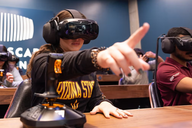You have /5 articles left.
Sign up for a free account or log in.

Faculty members are increasingly adding artificial intelligence tools and concepts into their curricula but say they need more support from administrators.
MTStock Studio/E+/Getty Images
Understanding generative artificial intelligence tools and their place in postsecondary education has been a challenge for administrators, faculty members and researchers, particularly considering AI’s importance in building skills for students’ future success.
Over the past few years, more individuals and institutions have experimented with and adopted tools such as chat bots and virtual reality to enhance student learning and engagement in the classroom.
A recently published report from researchers at Ithaka S+R found that regardless of their own feelings about artificial intelligence, the average professor sees the integration of AI tools into teaching and learning as inevitable, requiring faculty to engage with both the challenges and opportunities those tools present.
As a result, the report noted, colleges and universities should better support instructors with guidance and resources to improve faculty members’ and students’ AI literacy skills.
Methodology
Ithaka S+R engaged instructors and researchers through a series of 246 interviews at 19 colleges and universities in the U.S. and Canada in spring 2024. Participants included faculty, graduate students and postdoctoral students who hold teaching and research responsibilities at their institutions.
Using AI: The report authors found that faculty members’ familiarity with AI depended on their discipline. Professors in STEM fields were more likely to say they were specialists in AI and that their colleagues had similarly high levels of AI familiarity. Those in the social sciences, humanities or arts were less likely to report high familiarity with the tools, with the exception of those working at the intersection of tech and art.
Most instructors said they had at least experimented with integrating AI into classroom activities to help prepare students for their future careers. “Keeping up with students was a significant motivating factor for instructors to begin incorporating generative AI into their teaching activities,” the report said.
When teaching with AI, most work centered on improving AI literacy levels for students and instructors, including having students create content with generative AI tools, then evaluating the output under instructor supervision.
Instructors who incorporated such activities viewed them as successful, in that they helped address their own doubts that students have the literacy skills needed to safely interact with generative AI outside the classroom.
“But as common user knowledge of AI improves and new AI tools with different capabilities are released, AI literacy will be a moving target, requiring continual adaptation by instructors,” researchers noted.
Survey Says
A fall 2024 survey found that 48 percent of adults ages 18 to 59 have used generative AI, about five percentage points behind teens. About one in five teens said they had used generative artificial intelligence to write a report or paper, to summarize notes, or to edit a document. By comparison, roughly one in five adults said they used AI to edit a document or to draft an email.
Other instructors used AI to facilitate learning objectives, such as assisting students with coding skills or brainstorming project ideas. Fewer faculty members created assignments that encouraged students to use generative AI as a tutor or learning assistant.
Some instructors engaged with artificial intelligence themselves, using tools to create group activities or take-home practice problem sets in the classroom, or for evaluation such as AI-assisted feedback on student work or grading rubrics. “Having AI tools generate automated feedback for students was not a commonly discussed use of the technology among interviewees—their primary interest was having AI revise feedback they had written themselves,” according to the report.
Despite mounting pressures to utilize generative AI, some instructors shared they had yet to apply the tech to teaching and learning in any capacity. The most commonly cited challenge was learning how to use the tools themselves; some had not taught many or any classes since the emergence of generative AI, often due to sabbatical leave or holding an administrative position.
Sometimes instructors said they hadn’t identified appropriate use cases for students that didn’t circumvent important learning outcomes or shortcut skill-building.
Creating policy: While concerns remain high when it comes to students using generative AI tools unethically, interviewees said AI could never be effectively policed, making it nearly impossible to prove if a student had used the tool. Instead, instructors expressed a desire to engage students so they could build mutual trust and respect and effectively police themselves.
However, repeated cases of students misusing AI or breaching policies have led some instructors to ban the tools or re-evaluate policies.
Most interviewees said their institution did not hold a prescriptive stance on generative AI in the classroom; typically administrators offer syllabus language but give faculty the autonomy to build their own policies in the classroom. This can result in some confusion for students as they navigate varying policies or a lack of clear directives in some courses.
AI literacy is an area in which study participants indicated they wanted more formal departmental or institutionwide action, including teaching skills during new student onboarding, first-year courses or general education curricula.
New Resource
On May 6, Elon University and the American Association of Colleges and Universities published the second edition of the Student Guide to Artificial Intelligence, a free resource that addresses writing, research, data and creative work with AI, among other topics.
Supporting instructors: While many institutions have created support resources, including sample AI policy language or workshops, not every interviewee identified these measures as AI-related support. Participants who did recognize supports were more likely to talk about workshops and their usefulness.
Instructors were most likely to learn about AI through self-directed learning online (including YouTube tutorials, internet forums and social media or online tech courses), or from peers in the field.
When asked their preferences for support resources, instructors indicated they wanted events that accommodated their schedule (in-person and virtual, asynchronous and synchronous), were discipline-specific and allowed for peer-to-peer engagement. Further, professors expressed interest in secure access to tools for themselves and students, with many unaware of generative AI tools beyond ChatGPT and similar large language models.
How is your college or university training faculty or staff to engage with AI tools? Tell us more here.




